Delineation of Urban Growth Boundaries with SD and CLUE-s Models under Multi-Scenarios in Chengdu Metropolitan Area
Abstract
:1. Introduction
2. Literature Review
3. Study area and Data
3.1. Study Area
3.2. Data
4. Methods
4.1. SD Model for Land Use Demands Prediction
4.2. CLUE-s Model for Land Use Changes Simulation and Spatial Allocation
4.3. Integration of the SD Model with the CLUE-s Model
4.4. Land Use Changes Simulation and UGBs Delimiting
Land Use Demand Projections under Multi-scenarios
- A high speed socio-economic development scenario (S1), which means historical socio-economic developing speed will continue and land-use demand growth is still high.
- A moderate socio-economic development scenario (S2), which means that a comprehensive consideration of socio-economic development with ecological protection and land-use demands will be limited by a set of critical indicators.
- The new normal socio-economic development scenario (S3), which means more strict ecological projection and decreasing socio-economic development speed and reducing land-use demands in the study area. These scenarios were designed based on the Chinese or Chengdu city government’s policies. The socio-economic development factors were derived from historical data analyses. The critical indicators and their values used in the model are listed in Table 1. These indicators were selected after considering economic development, population growth, urbanization, food supply, and scientific-technological progress. In the land use demands simulation and projection process in the SD model, 66 parameters affecting land-use demands were considered. The spatial boundary for simulation and projection was the study area boundary, and the time limit was from 2000 to 2030.
5. Results and Analyses
5.1. Spatial Simulation and Results
5.2. UGBs Delineation
6. Conclusions and Discussion
Author Contributions
Funding
Conflicts of Interest
References
- Baizhan, L.; Runming, Y. Urbanisation and its impact on building energy consumption and efficiency in China. Renew. Energy 2009, 34, 1994–1998. [Google Scholar]
- Liu, Y. Exploring the relationship between urbanization and energy consumption in China using ARDL (autoregressive distributed lag) and FDM (factor decomposition model). Energy 2009, 34, 1846–1854. [Google Scholar] [CrossRef]
- Trisurat, Y.; Alkemade, R.; Verburg, P.H. Projecting land-use change and its consequences for biodiversity in Northern Thailand. Environ. Manag. 2010, 45, 626–639. [Google Scholar] [CrossRef] [PubMed]
- Nelson, A.C.; Duncan, J.B. Growth Management Principles and Practices; Planners Press, American Planning Association: Chicago, IL, USA; Washington, DC, USA, 1995. [Google Scholar]
- Jun, M.J. The effects of Portland’s urban growth boundary on housing prices. J. Am. Plan. Assoc. 2006, 72, 239–243. [Google Scholar] [CrossRef]
- Liang, X.; Liu, X.; Li, X.; Chen, Y.; Tian, H.; Yao, Y. Delineating multi-scenario urban growth boundaries with a CA-based FLUS model and morphological method. Landsc. Urban Plan. 2018, 177, 47–63. [Google Scholar] [CrossRef]
- Long, Y.; Han, H.; Lai, S.-K.; Mao, Q. Urban growth boundaries of the Beijing Metropolitan Area: Comparison of simulation and artwork. Cities 2013, 31, 337–348. [Google Scholar] [CrossRef]
- Han, H.Y.; Lai, S.K.; Dang, A.R.; Tan, Z.B.; Wu, C.F. Effectiveness of urban construction boundaries in Beijing:an assessment. J. Zhejiang Univ. A 2009, 10, 1285–1295. [Google Scholar] [CrossRef]
- Li, X.; Gong, P. Urban growth models: Progress and perspective. Sci. Bull. 2016, 61, 1637–1650. [Google Scholar] [CrossRef]
- Ma, S.F.; Ai, B.; Ou, J. Spatial allocation of construction land with constrained cellular automata model. Sci. Geogr. Sin. 2013, 33, 1245–1251. [Google Scholar]
- Batty, M. Cellular automata and urban form: A primer. J. Am. Plan. Assoc. 1997, 63, 266–274. [Google Scholar] [CrossRef]
- Batty, M.; Xie, Y. Urban growth using cellular automata models. In GIS, Spatial Analysis, and Modeling; Maguire, D.J., Batty, M., Goodchild, M.F., Eds.; ESRI Press: Redlands, CA, USA, 2005; pp. 151–172. [Google Scholar]
- Batty, M.; Xie, Y.; Sun, Z. Modeling urban dynamics through GIS-based cellular automata. Comput. Environ. Urban Syst. 1999, 23, 205–233. [Google Scholar] [CrossRef] [Green Version]
- Batty, M. Cities and Complexity: Understanding Cities with Cellular Automata, Agent-Based Models, and Fractals; The MIT Press: Cambridge, MA, USA, 2007. [Google Scholar]
- Barros, J. Exploring urban dynamics in Latin American cities using an agent-based simulation approach. In Agent-Based Models of Geographical Systems; Springer: Dordrecht, The Netherlands, 2012; pp. 571–589. [Google Scholar]
- Barros, J.X. Urban Growth in Latin American Cities—Exploring Urban Dynamics through Agent-Based Simulation. Ph.D. Thesis, University of London, London, UK, 2004. [Google Scholar]
- Clarke, K.C.; Gaydos, L.J. Loose-coupling a cellular automaton model and GIS: Long-term urban growth prediction for San Francisco and Washington/Baltimore. Int. J. Geogr. Inf. Sci. 1998, 12, 699–714. [Google Scholar] [CrossRef] [PubMed]
- Verburg, P.H.; Soepboer, W.; Veldkamp, A.; Limpiada, R.; Espaldon, V.; Mastura, S.S. Modeling the spatial dynamics of regional land use: The CLUE-S model. Environ. Manag. 2002, 30, 391–405. [Google Scholar] [CrossRef] [PubMed]
- Pontius, R.G.; Cornell, J.D.; Hall, C.A. Modeling the spatial pattern of land-use change with GEOMOD2: Application and validation for Costa Rica. Agric. Ecosyst. Environ. 2001, 85, 191–203. [Google Scholar] [CrossRef]
- Long, Y.; Han, H.; Mao, Q. Establishing urban growth boundaries using constrained CA. J. Geogr. Sci. 2009, 64, 999–1008. [Google Scholar]
- Liu, J.; Zhang, G.; Zhuang, Z.; Cheng, Q.; Gao, Y.; Chen, T.; Huang, Q.; Xu, L.; Chen, D. A new perspective for urban development boundary delineation based on SLEUTH-InVEST model. Habitat Int. 2017, 70, 13–23. [Google Scholar] [CrossRef]
- Zheng, Q.; Yang, X.; Wang, K.; Huang, L.; Shahtahmassebi, A.; Gan, M.; Weston, M.; Zheng, Q.; Yang, X.; Wang, K.; et al. Delimiting urban growth boundary through combining land suitability evaluation and cellular automata. Sustainability 2017, 9, 2213. [Google Scholar] [CrossRef]
- Verburg, P.H.; van Berkel, D.B.; van Doorn, A.M.; van Eupen, M.; van den Heiligenberg, H.A. Trajectories of land use change in Europe: A model-based exploration of rural futures. Landsc. Ecol. 2010, 25, 217–232. [Google Scholar] [CrossRef]
- Verburg, P.H.; Overmars, K.P.; Milne, E.; Aspinall, R.J.; Veldkamp, T.A. Combining top-down and bottom-up dynamics in land use modeling: Exploring the future of abandoned farmlands in Europe with the Dyna-CLUE model. Landsc. Ecol. 2009, 24, 1167. [Google Scholar] [CrossRef]
- Wang, Y.; Li, X.; Zhang, Q.; Li, J.; Zhou, X. Projections of future land use changes: Multiple scenarios-based impacts analysis on ecosystem services for Wuhan city, China. Ecol. Indic. 2018, 94, 430–445. [Google Scholar] [CrossRef]
- Zhang, P.; Liu, Y.; Pan, Y.; Yu, Z. Land use pattern optimization based on CLUE-S and SWAT models for agricultural non-point source pollution control. Math. Comput. Model. 2013, 58, 588–595. [Google Scholar] [CrossRef]
- Castella, J.-C.C.; Verburg, P.H. Combination of process-oriented and pattern-oriented models of land-use change in a mountain area of Vietnam. Ecol. Model. 2007, 202, 410–420. [Google Scholar] [CrossRef]
- Trisurat, Y.; Eawpanich, P.; Kalliola, R. Integrating land use and climate change scenarios and models into assessment of forested watershed services in Southern Thailand. Environ. Res. 2016, 147, 611–620. [Google Scholar] [CrossRef] [PubMed]
- Henríquez-Dole, L.; Usón, T.J.; Vicuña, S.; Henríquez, C.; Gironás, J.; Meza, F. Integrating strategic land use planning in the construction of future land use scenarios and its performance: The Maipo River Basin, Chile. Land Use Policy 2018, 78, 353–366. [Google Scholar] [CrossRef]
- Zhou, R.; Zhang, H.; Ye, X.-Y.; Wang, X.-J.; Su, H.-L.; Zhou, R.; Zhang, H.; Ye, X.-Y.; Wang, X.-J.; Su, H.-L. The delimitation of urban growth boundaries using the CLUE-S land-use change model: Study on Xinzhuang Town, Changshu City, China. Sustainability 2016, 8, 1182. [Google Scholar] [CrossRef]
- Lee, S.Y. An integrated model of land use/transportation system performance: System dynamics modeling approach. Transp. Res. Part A 1997, 1, 79. [Google Scholar]
- Chengdu Bureau of Statistics; Chengdu Statistical Society; Chengdu Investigation Team of National Bureau of Statistics. Chengdu Statistical Yearbook; Peng, Y., Ed.; China Statistics Press: Beijing, China, 2016.
- He, X. The Study on Co-Evolution and Simulation of Population, Resouces, and Economy in Chengdu Metropolitan Area Based on GIS/RS; National Natural Science Foundation of China: Beijing, China, 2016.
- Veldkamp, A.; Fresco, L.O.O. CLUE-CR: An integrated multi-scale model to simulate land use change scenarios in Costa Rica. Ecol. Model. 1996, 91, 231–248. [Google Scholar] [CrossRef]
- Veldkamp, A.; Fresco, L.O. CLUE: A conceptual model to study the conversion of land use and its effects. Ecol. Model. 1996, 85, 253–270. [Google Scholar] [CrossRef]
- Liang, Y.J.; Xu, Z.M. An integrated analysis approach to LUCC at regional scale: A case study in the Ganzhou District of Zhangye City, China. Sci. Cold Arid Reg. 2012, 4, 320–329. [Google Scholar]
- Pontius, R.G., Jr. Statistical methods to partition effects of quantity and location during comparison of categorical maps at multiple resolutions. Photogramm. Eng. Remote Sens. 2002, 68, 1041–1050. [Google Scholar]
- Pontius, R.G.; Schneider, L.C. Land-cover change model validation by an ROC method for the Ipswich watershed, Massachusetts, USA. Agric. Ecosyst. Environ. 2001, 85, 239–248. [Google Scholar] [CrossRef]
- WU, G.P.; Zeng, Y.N.; Feng, X.Z.; Xiao, P.F.; Wang, K. Dynamic simulation of land use change based on the improved CLUE-S model: A case study of Yongding County, Zhangjiajie. Geogr. Res. 2010, 29, 460–470. [Google Scholar]
- Youjia, L.; Zhongmin, X.; Fanglei, Z. Land use scenario analyses by based on system dynamic model and CLUE-S model at regional scale: A case study of Ganzhou district of Zhangye city. Geogr. Res. 2011, 30, 564–576. [Google Scholar]
- Verburg, P.H.; Eickhout, B.; van Meijl, H. A multi-scale, multi-model approach for analyzing the future dynamics of European land use. Ann. Reg. Sci. 2008, 42, 57–77. [Google Scholar] [CrossRef]

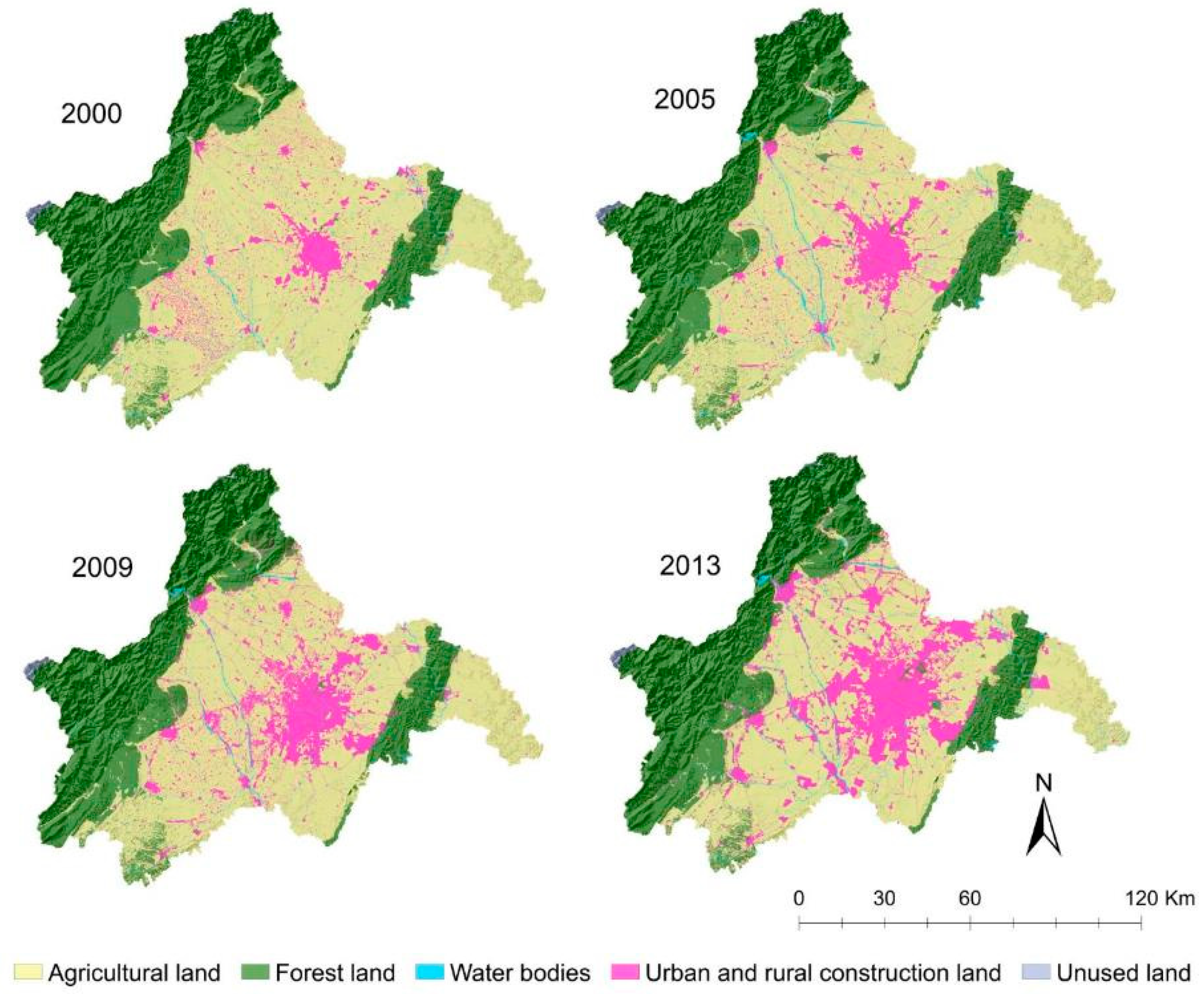
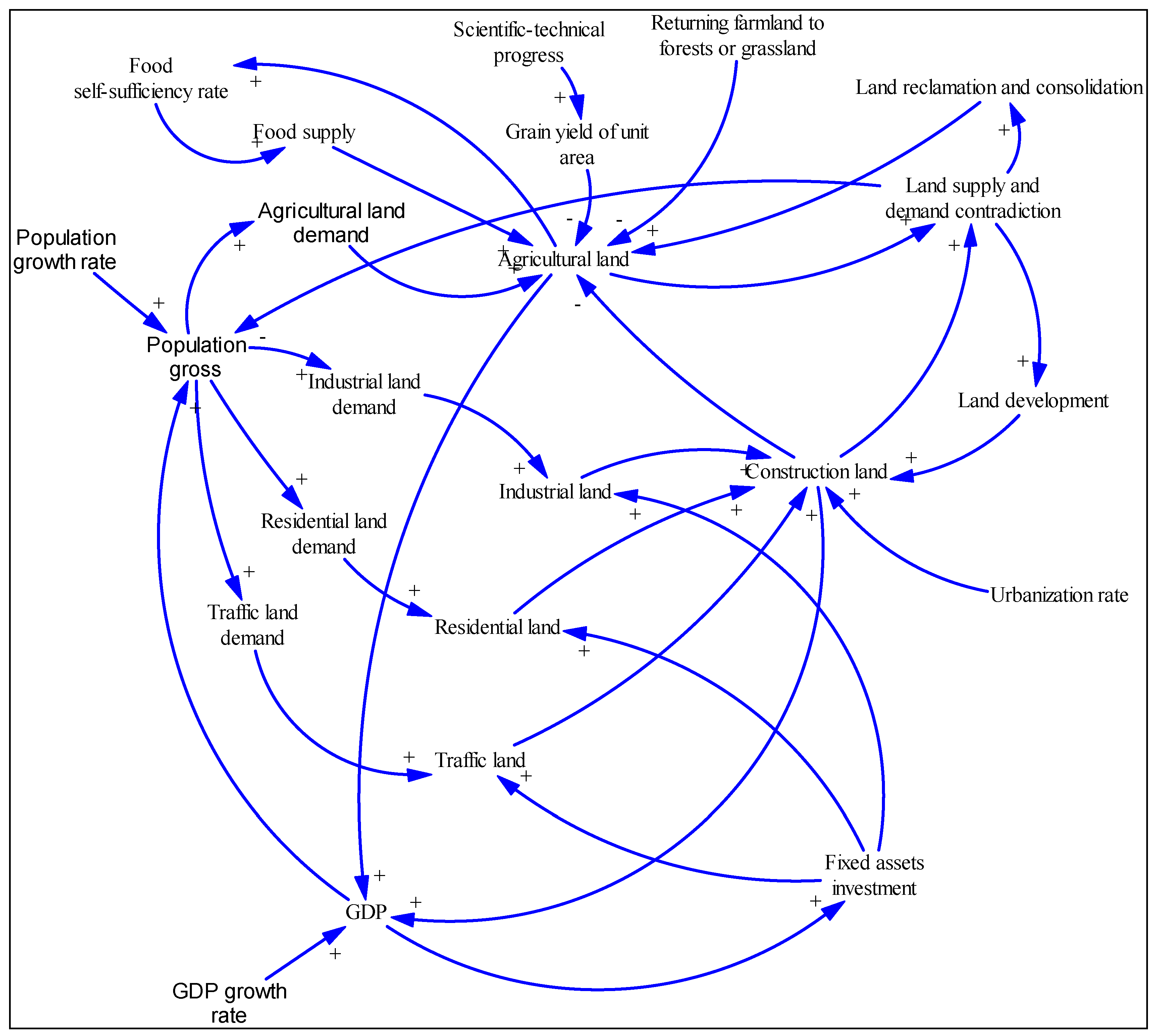
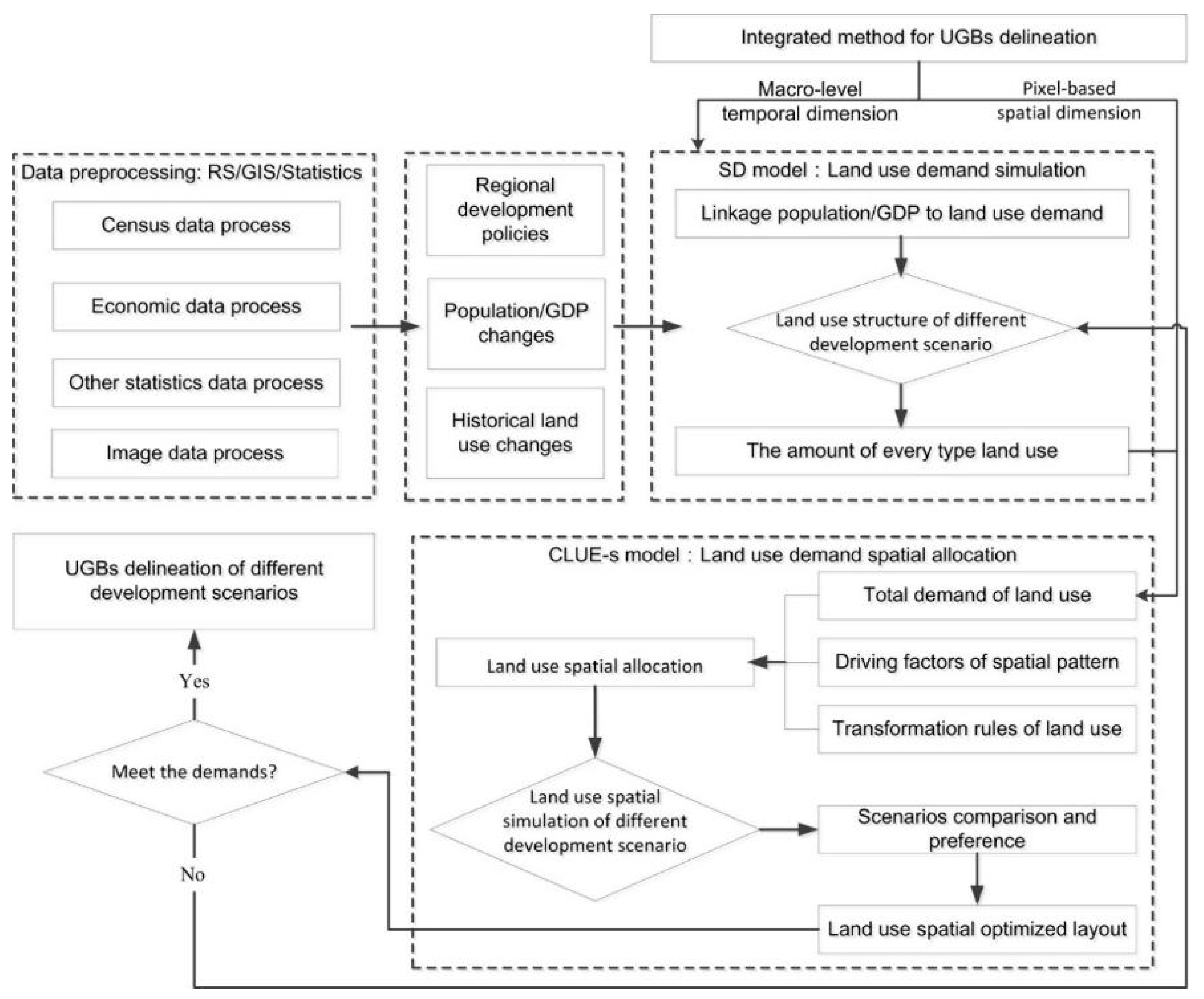
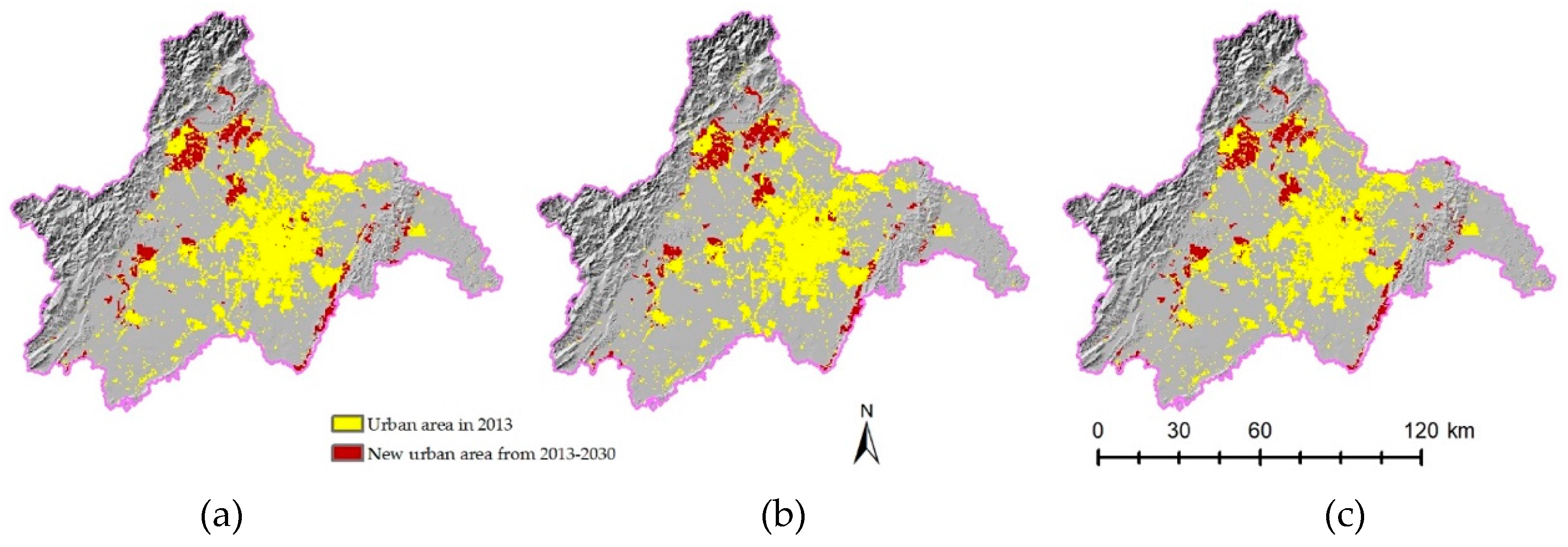
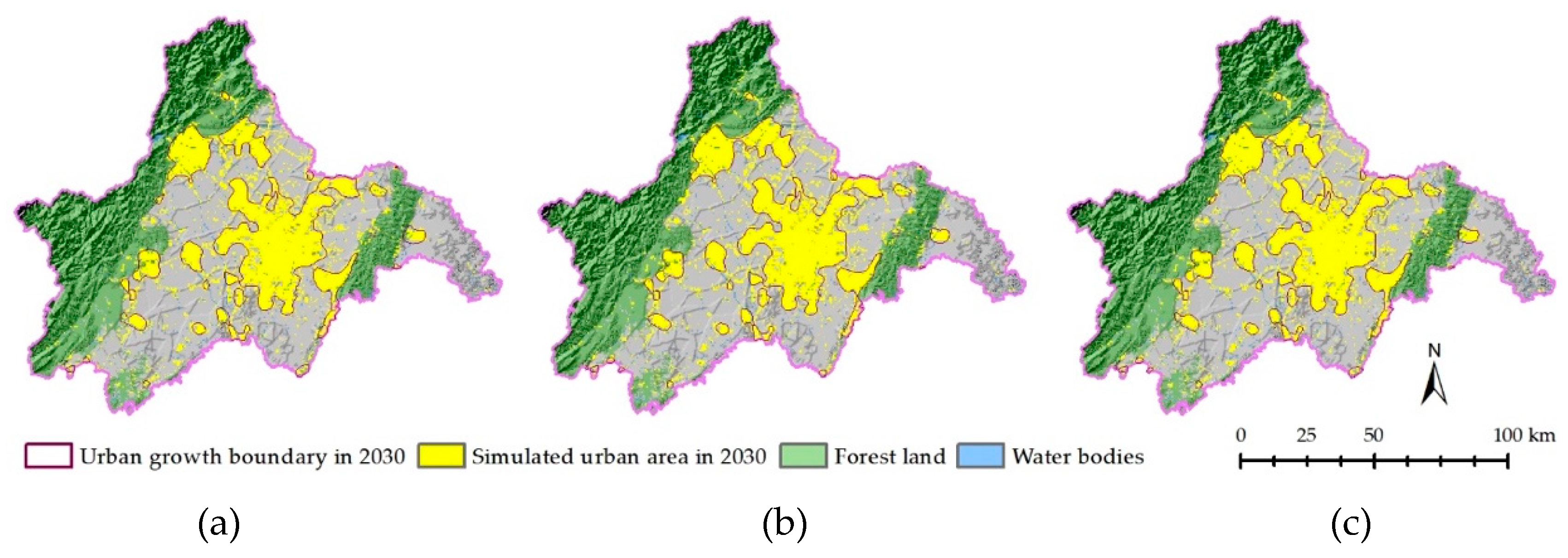
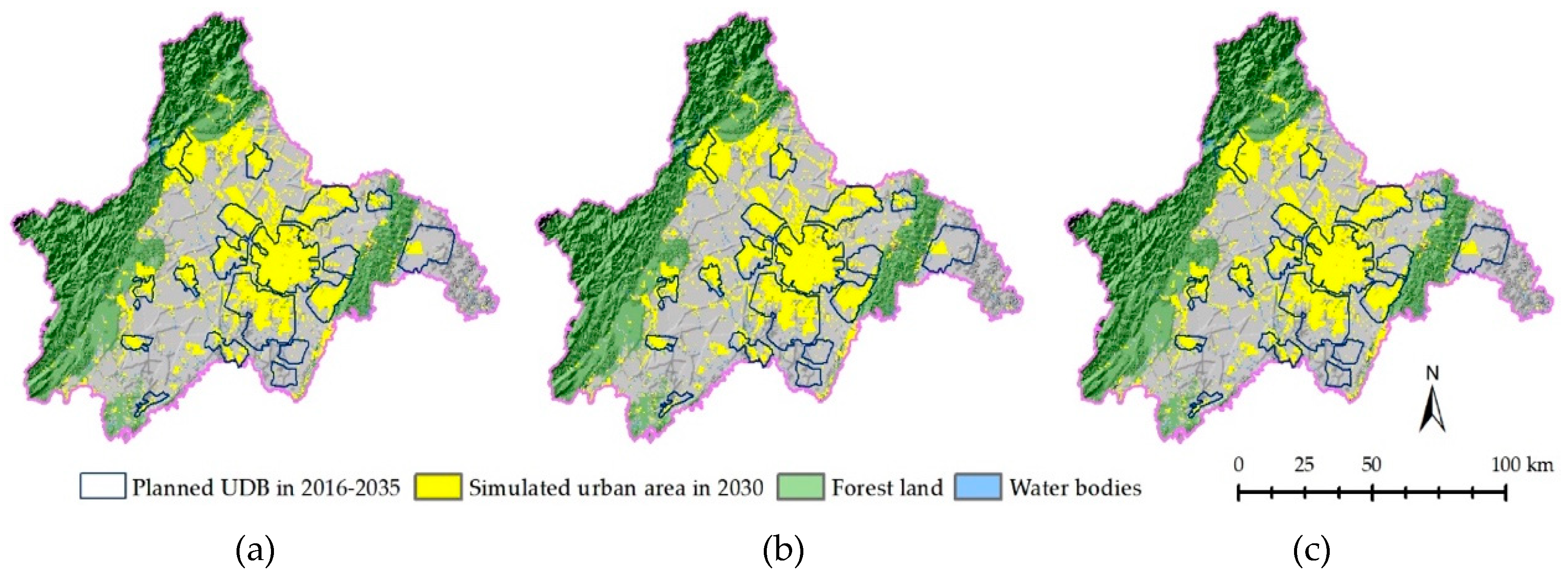
| Regional Factors | 2000–2013 | S1 | S2 | S3 |
|---|---|---|---|---|
| Natural population growth rate (‰) | 1.7 | 2 | 1.5 | 1 |
| GDP growth rate (%) | 13.4 | 13 | 10 | 7 |
| Fixed asset investment growth rate (%) | 20.11 | 22 | 20 | 15 |
| Urbanization rate (%) | 69.4 | 85 | 82 | 80 |
| Food self-sufficiency rate (%) | 59.27 | 40 | 55 | 50 |
| Land Use Type | 2005 | 2009 | 2013 | ||||||
|---|---|---|---|---|---|---|---|---|---|
| Actual Value | Predicted Value | Error | Actual Value | Predicted Value | Error | Actual Value | Predicted Value | Error | |
| Agricultural land | 6431 | 6403 | −0.44% | 6008 | 6012 | 0.06% | 5481 | 5498 | 0.30% |
| Forest land | 44,18 | 4433 | 0.34% | 4414 | 4430 | 0.38% | 4427 | 4423 | −0.09% |
| Water bodies | 250 | 249 | −0.40% | 177 | 179 | 1.13% | 219 | 209 | −4.38% |
| Construction land | 984 | 997 | 1.32% | 1483 | 1461 | −1.51% | 1956 | 1952 | −0.22% |
| Base | S1 | S2 | S3 | |||||||
|---|---|---|---|---|---|---|---|---|---|---|
| Year | 2013 | 2020 | 2025 | 2030 | 2020 | 2025 | 2030 | 2020 | 2025 | 2030 |
| Agricultural land | 5481 | 5232 | 5103 | 4999 | 5254 | 5120 | 5013 | 5250 | 5117 | 5010 |
| Forest land | 4427 | 4401 | 4395 | 4389 | 4402 | 4395 | 4389 | 4404 | 4398 | 4392 |
| Water bodies | 219 | 224 | 228 | 230 | 226 | 230 | 232 | 226 | 229 | 232 |
| Construction land | 1956 | 2226 | 2357 | 2464 | 2201 | 2337 | 2448 | 2202 | 2338 | 2449 |
| Unused land | 38 | 38 | 38 | 38 | 38 | 38 | 38 | 38 | 38 | 38 |
| Total areas | 12,121 | 12,121 | 12,121 | 12,121 | 12,121 | 12,121 | 12,121 | 12,121 | 12,121 | 12,121 |
© 2019 by the authors. Licensee MDPI, Basel, Switzerland. This article is an open access article distributed under the terms and conditions of the Creative Commons Attribution (CC BY) license (http://creativecommons.org/licenses/by/4.0/).
Share and Cite
He, X.; Mai, X.; Shen, G. Delineation of Urban Growth Boundaries with SD and CLUE-s Models under Multi-Scenarios in Chengdu Metropolitan Area. Sustainability 2019, 11, 5919. https://doi.org/10.3390/su11215919
He X, Mai X, Shen G. Delineation of Urban Growth Boundaries with SD and CLUE-s Models under Multi-Scenarios in Chengdu Metropolitan Area. Sustainability. 2019; 11(21):5919. https://doi.org/10.3390/su11215919
Chicago/Turabian StyleHe, Xindong, Xianmin Mai, and Guoqiang Shen. 2019. "Delineation of Urban Growth Boundaries with SD and CLUE-s Models under Multi-Scenarios in Chengdu Metropolitan Area" Sustainability 11, no. 21: 5919. https://doi.org/10.3390/su11215919





